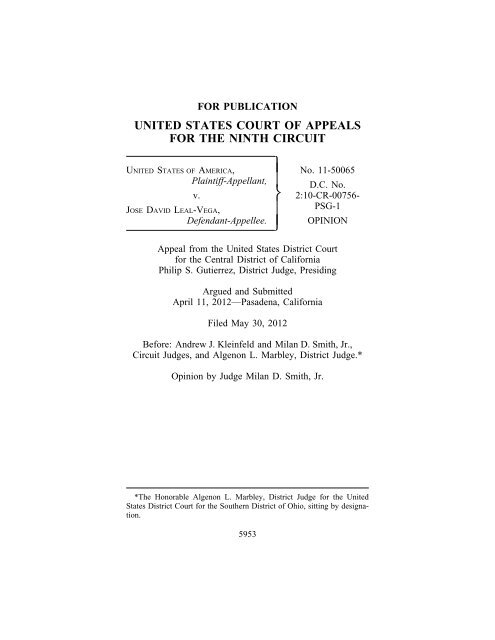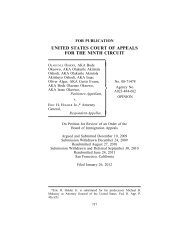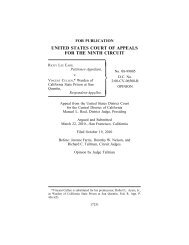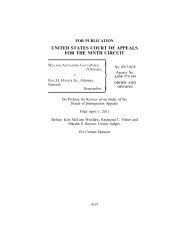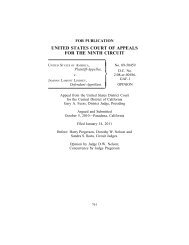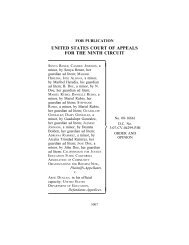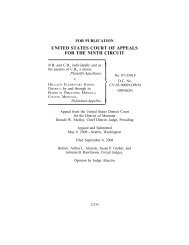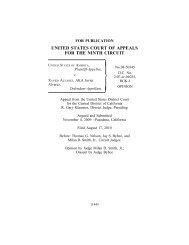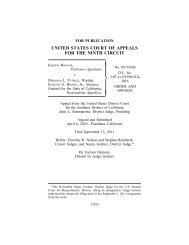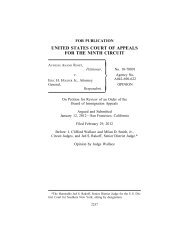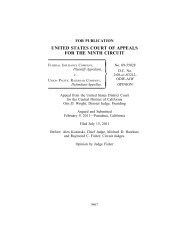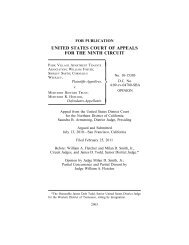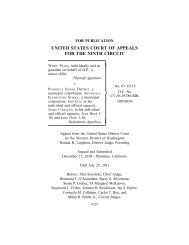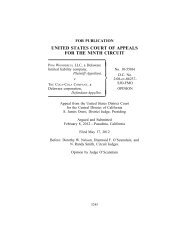U.S. v. Leal-Vega - Ninth Circuit Court of Appeals
U.S. v. Leal-Vega - Ninth Circuit Court of Appeals
U.S. v. Leal-Vega - Ninth Circuit Court of Appeals
Create successful ePaper yourself
Turn your PDF publications into a flip-book with our unique Google optimized e-Paper software.
FOR PUBLICATION<br />
UNITED STATES COURT OF APPEALS<br />
FOR THE NINTH CIRCUIT<br />
UNITED STATES OF AMERICA, No. 11-50065<br />
Plaintiff-Appellant, D.C. No.<br />
v. 2:10-CR-00756-<br />
PSG-1<br />
JOSE DAVID LEAL-VEGA,<br />
Defendant-Appellee. OPINION<br />
Appeal from the United States District <strong>Court</strong><br />
for the Central District <strong>of</strong> California<br />
Philip S. Gutierrez, District Judge, Presiding<br />
Argued and Submitted<br />
April 11, 2012—Pasadena, California<br />
Filed May 30, 2012<br />
Before: Andrew J. Kleinfeld and Milan D. Smith, Jr.,<br />
<strong>Circuit</strong> Judges, and Algenon L. Marbley, District Judge.*<br />
Opinion by Judge Milan D. Smith, Jr.<br />
*The Honorable Algenon L. Marbley, District Judge for the United<br />
States District <strong>Court</strong> for the Southern District <strong>of</strong> Ohio, sitting by designation.<br />
5953
5956 UNITED STATES v. LEAL-VEGA<br />
COUNSEL<br />
Peter William Baldwin, Curtis Arthur Kin, and Jean-Claude<br />
Andre (argued), Office <strong>of</strong> the United States Attorney, Los<br />
Angeles, California, for plaintiff-appellant United States <strong>of</strong><br />
America.<br />
Carlton Gunn (argued), Kaye McLane & Bednarski, LLP,<br />
Pasadena, California, for defendant-appellee Jose <strong>Leal</strong>-<strong>Vega</strong>.<br />
M. SMITH, <strong>Circuit</strong> Judge:<br />
OPINION<br />
The United States <strong>of</strong> America (Government) appeals the<br />
thirty-months sentence imposed on Jose <strong>Leal</strong>-<strong>Vega</strong> for illegal<br />
reentry following deportation. The district court declined to<br />
apply a sixteen-level enhancement pursuant to United States
UNITED STATES v. LEAL-VEGA<br />
Sentencing Guidelines, U.S.S.G. § 2L1.2, for <strong>Leal</strong>-<strong>Vega</strong>’s<br />
prior conviction under California Health & Safety Code<br />
§ 11351. The Government contends that the sixteen-level<br />
enhancement should have been applied because Section<br />
11351 is categorically a “drug trafficking <strong>of</strong>fense” under<br />
U.S.S.G. § 2L1.2. Alternatively, the Government contends<br />
that even if Section 11351 does not categorically qualify,<br />
<strong>Leal</strong>-<strong>Vega</strong>’s conviction qualifies as a “drug trafficking<br />
<strong>of</strong>fense” applying the modified categorical analysis because<br />
the substance involved was tar heroin, a substance covered by<br />
the federal Controlled Substances Act (CSA), 21 U.S.C. § 801<br />
et seq.<br />
We hold that a conviction under Section 11351 does not<br />
qualify categorically as a “drug trafficking <strong>of</strong>fense” for the<br />
purposes <strong>of</strong> U.S.S.G. § 2L1.2. However, we hold that <strong>Leal</strong>-<br />
<strong>Vega</strong>’s prior Section 11351 conviction qualifies as a “drug<br />
trafficking <strong>of</strong>fense” using the modified categorical approach,<br />
and we reverse and remand for resentencing.<br />
FACTUAL AND PROCEDURAL BACKGROUND<br />
5957<br />
On March 3, 1999, <strong>Leal</strong>-<strong>Vega</strong> was charged in Count 1 <strong>of</strong><br />
a felony complaint with “committ[ing] a violation <strong>of</strong> Health<br />
and Safety Code section 11351, a felony, in that on or about<br />
March 1, 1999, in the County <strong>of</strong> Riverside, State <strong>of</strong> California,<br />
[he] did wilfully and unlawfully possess for sale and purchase<br />
for purpose <strong>of</strong> sale a controlled substance, to wit, TAR<br />
HEROIN.” He was concurrently charged with another count.<br />
<strong>Leal</strong>-<strong>Vega</strong> pled guilty to Count 1, and the second count was<br />
dismissed.<br />
On August 23, 2010, <strong>Leal</strong>-<strong>Vega</strong> pled guilty to illegal reentry<br />
following deportation, under 8 U.S.C. § 1326. The information<br />
charged <strong>Leal</strong>-<strong>Vega</strong> with a prior 1999 felony<br />
conviction for possession <strong>of</strong> a controlled substance for sale,<br />
in violation <strong>of</strong> California Health & Safety Code § 11351.
5958 UNITED STATES v. LEAL-VEGA<br />
In the Presentence Report (PSR), the Probation Office recommended<br />
a sixteen-level enhancement based on the prior<br />
conviction, which it categorized as a “drug trafficking<br />
<strong>of</strong>fense.” <strong>Leal</strong>-<strong>Vega</strong> objected to this categorization, arguing<br />
that Section 11351 is categorically broader than the Sentencing<br />
Guidelines’s definition <strong>of</strong> a “drug trafficking <strong>of</strong>fense.”<br />
After initially arguing that Section 11351 was a categorical<br />
fit, the Government later conceded that the statute was too<br />
broad. Prior to sentencing, the district court requested more<br />
information for the purpose <strong>of</strong> conducting the modified categorical<br />
analysis. The Government subsequently retracted its<br />
concession regarding the inapplicability <strong>of</strong> the categorical<br />
analysis to Section 11351, and claimed that since the Sentencing<br />
Guidelines do not incorporate the CSA’s definition <strong>of</strong><br />
“controlled substance,” Section 11351 is not overbroad, and<br />
that the statute is a categorical fit.<br />
The district court concluded that Section 11351 was not<br />
categorically a “drug trafficking <strong>of</strong>fense,” and also found that<br />
the record <strong>of</strong> conviction for <strong>Leal</strong>-<strong>Vega</strong>’s 1999 conviction was<br />
insufficient to establish a modified categorical fit. Thus, the<br />
district court only applied a four-level sentence enhancement, 1<br />
and imposed a sentence <strong>of</strong> thirty months imprisonment, based<br />
on a calculated Guidelines range <strong>of</strong> twenty-four to thirty<br />
months. The Government timely appealed.<br />
JURISDICTION AND STANDARD OF REVIEW<br />
We have jurisdiction under 28 U.S.C. § 1291.<br />
We review de novo the district court’s interpretation <strong>of</strong> the<br />
Sentencing Guidelines. United States v. Cantrell, 433 F.3d<br />
1269, 1279 (9th Cir. 2006). We review the district court’s<br />
application <strong>of</strong> the Sentencing Guidelines for abuse <strong>of</strong> discretion.<br />
Id.<br />
1 This four-level enhancement is based on other prior felony convictions,<br />
which are not at issue in this appeal.
UNITED STATES v. LEAL-VEGA<br />
DISCUSSION<br />
[1] The crime <strong>of</strong> unlawfully entering the United States<br />
under 8 U.S.C. § 1326 carries a base <strong>of</strong>fense level <strong>of</strong> 8 under<br />
the Sentencing Guidelines. U.S.S.G. § 2L1.2; see United<br />
States v. Ballesteros-Ruiz, 319 F.3d 1101, 1102 (9th Cir.<br />
2003). A defendant’s base <strong>of</strong>fense level may be increased by<br />
sixteen levels if he has a prior conviction for a “drug trafficking<br />
<strong>of</strong>fense,” and the sentence on the prior conviction<br />
exceeded thirteen months. U.S.S.G. § 2L1.2(b)(1)(A). The<br />
Sentencing Guidelines define “drug trafficking <strong>of</strong>fense” as:<br />
[A]n <strong>of</strong>fense under federal, state, or local law that<br />
prohibits the manufacture, import, export, distribution,<br />
or dispensing <strong>of</strong>, or <strong>of</strong>fer to sell a controlled<br />
substance (or a counterfeit substance) or the possession<br />
<strong>of</strong> a controlled substance.<br />
5959<br />
Id. § 2L1.2, Application Notes (1)(B)(iv) (emphasis added).<br />
[2] We apply the categorical and modified categorical<br />
approaches described in Taylor v. United States, 495 U.S. 575<br />
(1990), to determine whether a defendant’s prior conviction<br />
satisfies U.S.S.G. § 2L1.2(b)(1)(A). United States v.<br />
Pimentel-Flores, 339 F.3d 959, 968 (9th Cir. 2003). We first<br />
apply the categorical analysis. Under this approach, we “do<br />
not examine the facts underlying the prior <strong>of</strong>fense, but look<br />
only to the fact <strong>of</strong> conviction and the statutory definition <strong>of</strong><br />
the prior <strong>of</strong>fense.” Id. at 967 (quoting United States v.<br />
Corona-Sanchez, 291 F.3d 1201, 1203 (9th Cir. 2002) (en<br />
banc), superseded on other grounds by U.S.S.G. § 2L.1, CMT<br />
n. 4 (2002)). If the statutory definition <strong>of</strong> the prior <strong>of</strong>fense<br />
criminalizes conduct that would not constitute a “drug trafficking<br />
<strong>of</strong>fense,” then the statute is not a categorical fit, and<br />
we must consider whether the prior conviction may still be<br />
used for a sentencing enhancement using the modified categorical<br />
approach. Id. We may not use the conviction for a sentencing<br />
enhancement unless “the record includes
5960 UNITED STATES v. LEAL-VEGA<br />
documentation or judicially noticeable facts that clearly establish<br />
that the conviction is a predicate for enhancement purposes.”<br />
Id. (quoting Corona-Sanchez, 291 F.3d at 1203).<br />
Finally, if both the statute and the documents containing judicially<br />
noticeable facts would allow the defendant to be convicted<br />
<strong>of</strong> an <strong>of</strong>fense that would not be a “drug trafficking<br />
<strong>of</strong>fense,” then the sentencing enhancement may not be<br />
applied. See Corona-Sanchez, 291 F.3d at 1203-04.<br />
[3] The predicate <strong>of</strong>fense here, California Health & Safety<br />
Code § 11351, criminalizes “possess[ion] for sale or purchases<br />
for purposes <strong>of</strong> sale (1) any controlled substance specified<br />
in subdivision (b), (c), or (e) <strong>of</strong> Section 11054, specified<br />
in paragraph (14), (15), or (20) <strong>of</strong> subdivision (d) <strong>of</strong> Section<br />
11054, or specified in subdivision (b) or (c) <strong>of</strong> Section 11055,<br />
or specified in subdivision (h) <strong>of</strong> Section 11056, or (2) any<br />
controlled substance classified in Schedule III, IV, or V which<br />
is a narcotic drug.” Cal. Health & Safety Code § 11351.<br />
I. Categorical Analysis<br />
Applying the initial step in the Taylor analysis, we first<br />
determine whether Section 11351 categorically qualifies as a<br />
“drug trafficking <strong>of</strong>fense,” as defined under the Sentencing<br />
Guidelines. In particular, we must determine how to interpret<br />
the term “controlled substance,” as it is used in the Sentencing<br />
Guidelines definition. If we construe the term as being tied to<br />
the federal definition <strong>of</strong> controlled substances from the CSA,<br />
Section 11351 cannot qualify categorically because it criminalizes<br />
possession or purchase <strong>of</strong> substances that are not<br />
included in the CSA. See infra. However, were we to adopt<br />
the definition <strong>of</strong> “controlled substance” urged by the<br />
Government—that it takes on its ordinary, common sense<br />
meaning, as a drug regulated by law—Section 11351 would<br />
automatically qualify categorically.<br />
While we have not applied the Taylor categorical analysis<br />
to determine whether various California drug statutes would
UNITED STATES v. LEAL-VEGA<br />
5961<br />
qualify as a “drug trafficking <strong>of</strong>fense” in the Sentencing<br />
Guidelines context, we have found occasion to do so in the<br />
immigration framework. First, in Ruiz-Vidal v. Gonzalez, 473<br />
F.3d 1072 (9th Cir. 2007), we held that California Health &<br />
Safety Code § 11377 could not serve as a predicate <strong>of</strong>fense<br />
for removal under 8 U.S.C. § 1227(a). We stated that there<br />
was no categorical fit because “California law regulates the<br />
possession and sale <strong>of</strong> numerous substances that are not similarly<br />
regulated by the CSA.” Id. at 1078. Next, in Mielewczyk<br />
v. Holder, 575 F.3d 992, 995 (9th Cir. 2009), we held that<br />
California Health & Safety Code § 11352 was categorically<br />
too broad, under 8 U.S.C. § 1227(a). We held the same in S-<br />
Yong v. Holder, 600 F.3d 1028, 1034 (9th Cir. 2010), addressing<br />
California Health & Safety Code § 11379.<br />
[4] Were we to interpret “drug trafficking <strong>of</strong>fense” in the<br />
sentencing context to be consistent with our interpretation in<br />
the immigration context, i.e., that its meaning is defined by<br />
the CSA, Section 11351 would be too broad to categorically<br />
qualify as a “drug trafficking <strong>of</strong>fense.” The statute at issue in<br />
Mielewczyk, California Health & Safety Code § 11352(a), differs<br />
from Section 11351 only in that it includes cocaine base.<br />
Compare Cal. Health & Safety Code § 11351 (listing numerous<br />
subsections and subparagraphs <strong>of</strong> controlled substances<br />
schedule statutes) with id. § 11352(a) (listing same subsections<br />
and subparagraphs, with one addition, subparagraph<br />
(f)(1) <strong>of</strong> Section 11054); see id. § 11054(f)(1) (cocaine base).<br />
Cocaine base was not the reason we found Section 11352 to<br />
be too broad in Mielewczyk, because cocaine base is covered<br />
by the CSA. See 21 U.S.C. § 841(b)(1)(A)(iii), (b)(1)(B)(iii).<br />
Thus, like Section 11352, Section 11351 also criminalizes<br />
possession or purchase <strong>of</strong> substances that are not covered<br />
under the CSA.<br />
We acknowledge that our holdings in the immigration context<br />
do not definitively resolve the issue we address here<br />
because the text <strong>of</strong> the immigration statute 8 U.S.C. § 1227(a)
5962 UNITED STATES v. LEAL-VEGA<br />
differs from the text <strong>of</strong> the Sentencing Guidelines we interpret.<br />
The immigration statutes make deportable:<br />
Any alien who at any time after admission has been<br />
convicted <strong>of</strong> a violation <strong>of</strong> (or a conspiracy or<br />
attempt to violate) any law or regulation <strong>of</strong> a State,<br />
the United States, or a foreign country relating to a<br />
controlled substance (as defined in section 802 <strong>of</strong><br />
Title 21), other than a single <strong>of</strong>fense involving possession<br />
for one’s own use <strong>of</strong> 30 grams or less <strong>of</strong><br />
marijuana.<br />
8 U.S.C. § 1227(a)(2)(B)(i). Thus, the text <strong>of</strong> the immigration<br />
statute states that the “controlled substance” must be one that<br />
is “defined in section 802 <strong>of</strong> Title 21,” which is the CSA.<br />
In contrast, the pertinent language in the Sentencing Guidelines<br />
differs from that <strong>of</strong> 8 U.S.C. § 1227(a)(2)(B)(i) because<br />
the term “controlled substances” is not therein expressly<br />
linked to the CSA. The Government asks us to find that this<br />
lack <strong>of</strong> explicit incorporation <strong>of</strong> the CSA into the Sentencing<br />
Guidelines means that the Sentencing Guidelines do not limit<br />
the definition <strong>of</strong> “controlled substances” to the substances<br />
found in the CSA. In support <strong>of</strong> its position, the Government<br />
points to other portions <strong>of</strong> the Sentencing Guidelines which<br />
explicitly incorporate federal statutory definitions. See, e.g.<br />
U.S.S.G. § 2L1.2 Application Notes (1)(B)(i) (defining “alien<br />
smuggling <strong>of</strong>fense” to refer to the meaning in 8 U.S.C.<br />
§ 1101(a)(43)(N); id. Application Notes (1)(B)(v) (defining<br />
“firearms <strong>of</strong>fense” to refer to firearms as described in 18<br />
U.S.C. § 921). The Government also contends that the history<br />
<strong>of</strong> the drafting <strong>of</strong> the Sentencing Guidelines counsels against<br />
incorporation <strong>of</strong> the CSA into the definition <strong>of</strong> “controlled<br />
substances.” We reject these arguments, which are rooted in<br />
canons <strong>of</strong> statutory interpretation and presumptions <strong>of</strong> Congressional<br />
intent under Russello v. United States, 464 U.S. 16<br />
(1983), because accepting the Government’s position would<br />
undermine the reasoning underlying the categorical analysis
UNITED STATES v. LEAL-VEGA<br />
in the first place, as articulated in Taylor, as well as the purpose<br />
<strong>of</strong> the Sentencing Guidelines.<br />
Taylor aspires to “a single national” definition <strong>of</strong> a given<br />
crime under its categorical approach and we have recognized<br />
that the definition should include generic elements <strong>of</strong> the<br />
<strong>of</strong>fense at issue. See Estrada-Espinoza v. Mukasey, 546 F.3d<br />
1147, 1157-58 (9th Cir. 2008) (en banc).<br />
The underlying theory <strong>of</strong> Taylor is that a national<br />
definition <strong>of</strong> the elements <strong>of</strong> a crime is required so<br />
as to permit uniform application <strong>of</strong> federal law in<br />
determining the federal effect <strong>of</strong> prior convictions<br />
. . . . Without defined elements a comparison <strong>of</strong> the<br />
state statute with a federally-defined generic <strong>of</strong>fense<br />
is not possible.<br />
5963<br />
Id. (internal citations and footnotes omitted). The purpose <strong>of</strong><br />
the generic definition as envisioned in Taylor was to ensure<br />
that there is some “uniform definition independent <strong>of</strong> the<br />
labels employed by various [s]tates’ criminal codes.” United<br />
States v. Aguila-Montes de Oca, 655 F.3d 915, 920 (9th Cir.<br />
2011) (en banc) (quoting Taylor, 495 U.S. at 589). Applying<br />
these principles to the issue before us, the meaning <strong>of</strong> “drug<br />
trafficking <strong>of</strong>fense” should not “depend on the definition<br />
adopted by the State <strong>of</strong> conviction.” Taylor, 495 U.S. at 589;<br />
see also United States v. Hudson, 618 F.3d 700, 703-05 (7th<br />
Cir. 2010) (“There is no reason why the guidelines [sic] must<br />
be restricted to a particular state’s concept <strong>of</strong> what is meant<br />
by that term.”).<br />
The Government contends that its position is still viable<br />
notwithstanding Taylor’s focus. “The Guidelines include a<br />
specific national definition for ‘drug trafficking <strong>of</strong>fense’—the<br />
only question is whether the phrase ‘controlled substance’<br />
within that definition should take its broad ordinary meaning<br />
or should incorporate the specific list <strong>of</strong> the substances . . .<br />
under the CSA.” This contention fails because defining the
5964 UNITED STATES v. LEAL-VEGA<br />
term “controlled substance” to have its ordinary meaning <strong>of</strong><br />
a drug regulated by law would make what <strong>of</strong>fenses constitute<br />
a drug <strong>of</strong>fense necessarily depend on the state statute at issue.<br />
The criminal act at issue here—possession or purchase <strong>of</strong><br />
a controlled substance—is a crime because California defined<br />
certain substances, such as tar heroin, as being controlled.<br />
This crime is <strong>of</strong> a different nature than certain other crimes<br />
for which the courts have provided generic definitions. For<br />
example, in Taylor, the <strong>Court</strong> defined “burglary” to be any<br />
crime with the elements <strong>of</strong> “unlawful or unprivileged entry<br />
into, or remaining in, a building or other structure, with intent<br />
to commit a crime.” Taylor, 495 U.S. at 598. Thus, even if a<br />
state named a crime with these elements something different<br />
than “burglary,” the generic definition <strong>of</strong> the crime <strong>of</strong> “burglary”<br />
would still be met as long as the crime, under whatever<br />
name, required those elements. On the other hand, what<br />
makes the act <strong>of</strong> possessing or purchasing a substance for sale<br />
illegal under Section 11351 is the fact that the substance must<br />
be “controlled,” under state law. Thus, under the Government’s<br />
position, the definition <strong>of</strong> what is a “controlled substance”<br />
is necessarily dependent on the state law.<br />
The Government next suggests that we can properly incorporate<br />
the ordinary meaning <strong>of</strong> the term “controlled substance”<br />
into Section 11351 in the same way that courts have<br />
adopted an ordinary meaning for the term “counterfeit substance.”<br />
Several circuits have found the meaning <strong>of</strong> “counterfeit<br />
substance” to be based on its plain, ordinary meaning,<br />
without reference to the CSA, even though the term “counterfeit<br />
substance” is also defined in the CSA. See, e.g., United<br />
States v. Hudson, 618 F.3d 700, 703-05 (7th Cir. 2010);<br />
United States v. Mills, 485 F.3d 219, 222-26 (4th Cir. 2007);<br />
United States v. Robertson, 474 F.3d 538, 540-41 (8th Cir.<br />
2007); United States v. Crittenden, 372 F.3d 706, 707-10 (5th<br />
Cir. 2004); United States v. Frazier, 89 F.3d 1501, 1505 (11th<br />
Cir. 1996).
UNITED STATES v. LEAL-VEGA<br />
5965<br />
We find an important distinction between the terms “counterfeit<br />
substances” and “controlled substances.” The word<br />
“counterfeit” has a normal, everyday meaning that we all<br />
understand. See Merriam-Webster’s Collegiate Dictionary<br />
285 (11th ed. 2005) (defining “counterfeit” as “made in imitation<br />
<strong>of</strong> something else with the intent to deceive: forged”);<br />
Black’s Law Dictionary 375 (8th ed. 2004) (defining “counterfeit”<br />
as “to unlawfully forge, copy or imitate an item . . .<br />
or to possess such an item without authorization and with the<br />
intent to deceive or defraud by presenting the item as genuine”).<br />
Accordingly, various courts have defined this term to<br />
include two components based on plain meaning: made (1) in<br />
imitation and (2) with intent to deceive. See Robertson, 474<br />
F.3d at 541; Crittenden, 372 F.3d at 708. This definition <strong>of</strong><br />
“counterfeit substances” has an independent meaning from<br />
however it may be defined in a specific state or federal statute.<br />
The same is not true <strong>of</strong> the word “controlled.” While the<br />
word “controlled” may have a plain and ordinary meaning, 2<br />
whether a substance is “controlled” must, <strong>of</strong> necessity, be<br />
tethered to some state, federal, or local law in a way that is<br />
not true <strong>of</strong> the definition <strong>of</strong> “counterfeit.” To construe the<br />
term “controlled” as the Government urges would require the<br />
Sentencing Guidelines to take into account the substances that<br />
individual states “control.” This would be contrary to the goal<br />
<strong>of</strong> the Sentencing Guidelines to seek “reasonable uniformity<br />
in sentencing by narrowing the wide disparity in sentences<br />
imposed for similar criminal <strong>of</strong>fenses committed by similar<br />
<strong>of</strong>fenders.” U.S.S.G. Ch. One, Pt. A.<br />
2 The term “controlled substance” has been defined to mean a drug regulated<br />
by law. See, e.g., Black’s Law Dictionary (2009 ed.) (“Any type <strong>of</strong><br />
drug whose possession and use is regulated by law, including a narcotic,<br />
a stimulant, or a hallucinogen.”); Oxford English Dictionary (“[A]n addictive<br />
or behaviour-altering drug: restricted by law in respect <strong>of</strong> availability,<br />
possession, or use.”); American Heritage Dictionary (4th ed. 2000) (“A<br />
drug or chemical substance whose possession and use are regulated under<br />
the Controlled Substances Act.”).
5966 UNITED STATES v. LEAL-VEGA<br />
[5] In light <strong>of</strong> the above, we decline to adopt the Government’s<br />
position that the term “controlled substance” should<br />
mean any substance controlled by law. In order to effectuate<br />
the goal set forth in Taylor <strong>of</strong> arriving at a national definition<br />
to permit uniform application <strong>of</strong> the Sentencing Guidelines,<br />
we hold that the term “controlled substance,” as used in the<br />
“drug trafficking <strong>of</strong>fense” definition in U.S.S.G. § 2L1.2,<br />
means those substances listed in the CSA. Our holding today<br />
harmonizes the definition in the Sentencing Guidelines with<br />
the immigration statute, and makes the Taylor analysis under<br />
these two schemes consistent for these <strong>of</strong>fenses. Our holding<br />
is also consistent with the reasoning <strong>of</strong> the Eighth <strong>Circuit</strong>,<br />
which reached the same conclusion regarding whether California<br />
Health & Safety Code § 11378 constituted a drug trafficking<br />
<strong>of</strong>fense under U.S.S.G. § 2L1.2. United States v.<br />
Sanchez-Garcia, 642 F.3d 658, 661-62 (8th Cir. 2011) (recognizing<br />
that the California statute and Sentencing Guidelines<br />
used the term “controlled substance” but that the Sentencing<br />
Guidelines did not define the term, and adopting the defendant’s<br />
position that the term should be defined as substances<br />
listed in the CSA); see also United States v. Benitez-de Los<br />
Santos, 650 F.3d 1157, 1159-60 (8th Cir. 2011) (assuming<br />
that CSA applies and that the categorical analysis does not<br />
apply to California Health & Safety Code § 11351 under the<br />
Sentencing Guidelines).<br />
[6] We conclude that Section 11351 is categorically<br />
broader than the Guidelines definition <strong>of</strong> “drug trafficking<br />
<strong>of</strong>fense” because it criminalizes possession or purchase <strong>of</strong><br />
certain substances that are not covered by the CSA. See Ruiz-<br />
Vidal, 473 at 1078; Mielewczyk, 575 F.3d at 995. Accordingly,<br />
we hold that Section 11351 does not categorically qualify<br />
as a “drug trafficking <strong>of</strong>fense” under U.S.S.G. § 2L1.2.<br />
II. Modified Categorical Analysis<br />
[7] We next apply the modified categorical analysis to<br />
determine if <strong>Leal</strong>-<strong>Vega</strong>’s prior conviction qualifies as a “drug
UNITED STATES v. LEAL-VEGA<br />
5967<br />
trafficking <strong>of</strong>fense.” Under the modified categorical approach,<br />
we may not look beyond the record <strong>of</strong> conviction to the particular<br />
facts underlying the conviction. United States v. Vidal,<br />
504 F.3d 1072, 1086 (9th Cir. 2007) (en banc). Our inquiry<br />
is limited to “the charging document, the terms <strong>of</strong> a plea<br />
agreement or transcript <strong>of</strong> colloquy between judge and defendant<br />
in which the factual basis for the plea was confirmed by<br />
the defendant, or to some comparable judicial record <strong>of</strong> this<br />
information.” Shepard v. United States, 544 U.S. 13, 26<br />
(2005); Ruiz-Vidal, 473 F.3d at 1078. We held in United<br />
States v. Snellenberger, 548 F.3d 699, 701 (9th Cir. 2008) (en<br />
banc), that we may also consider documents <strong>of</strong> “equal reliability,”<br />
including, but not limited to, a clerk’s minute order.<br />
Several judicially noticeable documents concerning <strong>Leal</strong>-<br />
<strong>Vega</strong>’s conviction were before the district court. The 1999<br />
felony complaint charged in Count 1 “[t]hat the above named<br />
defendants committed a violation <strong>of</strong> Health and Safety Code<br />
Section § 11351, a felony, in that on or about March 1, 1999,<br />
in the County <strong>of</strong> Riverside, State <strong>of</strong> California, they did wilfully<br />
and unlawfully possess for sale and purchase for purpose<br />
<strong>of</strong> sale a controlled substance, to wit, TAR HEROIN.” Tar heroin<br />
is controlled under the CSA as a Schedule I drug. 21<br />
U.S.C. § 812. An abstract <strong>of</strong> judgment stated that <strong>Leal</strong>-<strong>Vega</strong><br />
was convicted <strong>of</strong> count 1 under HS 11351P for “Selling Contoll.<br />
[sic]” A minute order stated that “Defendant pleads<br />
Guilty to Count(s) 1” and the charges are listed as “1) 11351<br />
HS-F C.” Finally, a felony plea form stated that the “defendant<br />
is to enter a guilty plea to the following charges and/or<br />
enhancements” followed by a handwritten “11351 H+S.”<br />
<strong>Leal</strong>-<strong>Vega</strong> contends that these documents which establish<br />
that he pled guilty to “Count 1” are not sufficiently reliable<br />
to be considered under the modified categorical approach. We<br />
reject this argument because <strong>of</strong> our prior holdings to the contrary.<br />
The minute order stating that <strong>Leal</strong>-<strong>Vega</strong> pled guilty to<br />
“Count 1” may be considered under Snellenberger. 548 F.3d<br />
at 701-02. The minute order at issue here is <strong>of</strong> sufficient reli-
5968 UNITED STATES v. LEAL-VEGA<br />
ability because it is similarly “prepared by a court <strong>of</strong>ficial at<br />
the time the guilty plea is taken” and “[t]he clerk presumably<br />
exercises that duty as faithfully and diligently as, for example,<br />
court reporters, upon whose transcripts we regularly depend.”<br />
Id. at 702. Moreover, the abstract <strong>of</strong> judgment stating that<br />
<strong>Leal</strong>-<strong>Vega</strong> was convicted <strong>of</strong> “Count 1” may be considered<br />
under Ramirez-Villalpando v. Holder, 645 F.3d 1035 (9th Cir.<br />
2011). We clarified in Ramirez-Villalpando that an abstract <strong>of</strong><br />
judgment could be used, if it is not the only document that is<br />
used to determine if a prior <strong>of</strong>fense meets the modified categorical<br />
approach. Id. at 1040. Thus, both these documents<br />
may be used, in conjunction with the felony complaint, under<br />
the modified categorical analysis.<br />
[8] We hold that the record <strong>of</strong> conviction establishes that<br />
<strong>Leal</strong>-<strong>Vega</strong> was convicted <strong>of</strong> possession <strong>of</strong> tar heroin. The felony<br />
complaint narrowed the charge and stated that <strong>Leal</strong>-<strong>Vega</strong><br />
was charged under Count 1 with possession for sale <strong>of</strong> tar heroin<br />
under Section 11351. Both the minute order and the<br />
abstract <strong>of</strong> judgment confirm that he pled guilty to “Count 1,”<br />
under Section 11351. No evidence in the record suggests that<br />
any modifications were made to the felony complaint in terms<br />
<strong>of</strong> the substance involved. Thus, no ambiguity exists and no<br />
further clarifying language was necessary. See Snellenberger,<br />
548 F.3d at 701-702.<br />
We find Snellenberger to be directly on point. The minute<br />
order in Snellenberger stated that the defendant pled nolo<br />
contendere to count 1. 548 F.3d at 701. Count 1 from the<br />
charging document established the federal <strong>of</strong>fense <strong>of</strong> burglary.<br />
Id. We concluded that “[t]ogether, these lines establish<br />
that Snellenberger pleaded nolo contendere to count 1, which<br />
charged him with ‘enter[ing] an inhabited dwelling house and<br />
trailer coach and inhabited portion <strong>of</strong> a building occupied by<br />
Peter MacPherson, with the intent to commit larceny and any<br />
felony’ ” and thus, the documents establish that Snellenberger<br />
committed burglary <strong>of</strong> a dwelling. Id. For <strong>Leal</strong>-<strong>Vega</strong>, both the<br />
minute order and abstract <strong>of</strong> judgment state that <strong>Leal</strong>-<strong>Vega</strong>
pled guilty to Count 1. Count 1 in the complaint identified the<br />
substance as tar heroin. This is the exact situation we faced in<br />
Snellenberger.<br />
In contrast, the factual situation in United States v. Vidal,<br />
the case relied on by <strong>Leal</strong>-<strong>Vega</strong>, was quite different. In Vidal,<br />
the felony complaint charged the defendant in Count one with<br />
“willfully and unlawfully driv[ing] and tak[ing] a vehicle . . .<br />
without the consent <strong>of</strong> and with intent to deprive the owner<br />
<strong>of</strong> title to and possession <strong>of</strong> said vehicle, in violation <strong>of</strong> Vehicle<br />
Code Section 10851(a).” 504 F.3d at 1075 (emphasis<br />
added). However, the defendant only pled guilty to “Count 1<br />
10851(a) VC Driving a Stolen Vehicle,” as reflected in the<br />
written plea form. Id. at 1087. Thus, the language in the plea<br />
only referred to “[d]riving a stolen vehicle” and did not<br />
include anything about driving and taking the vehicle without<br />
consent, as the felony complaint charged. We held that “the<br />
paltry record before the district court does not eliminate the<br />
possibility that Vidal was convicted as an accessory after the<br />
fact to theft, which we have concluded does not fall within the<br />
generic theft <strong>of</strong>fense.” Id. at 1089. There is no such “paltry<br />
record” here—rather, the only substance referred to in the<br />
record <strong>of</strong> conviction is tar heroin. On this record, we cannot<br />
conclude that there is any reasonable possibility that <strong>Leal</strong>-<br />
<strong>Vega</strong>’s conviction was based on possession <strong>of</strong> another substance.<br />
[9] We hold that the felony complaint, read together with<br />
the minute order and abstract <strong>of</strong> judgment, are sufficient<br />
under the modified categorical approach to establish that<br />
<strong>Leal</strong>-<strong>Vega</strong> plead guilty to possession with the purpose <strong>of</strong> sale<br />
<strong>of</strong> tar heroin, a substance included in the CSA. Thus, his prior<br />
conviction constitutes a “drug trafficking <strong>of</strong>fense” under<br />
U.S.S.G. § 2L1.2, and a sixteen-level sentencing enhancement<br />
should have been applied.<br />
III. Harmless Error<br />
UNITED STATES v. LEAL-VEGA<br />
5969<br />
Finally, <strong>Leal</strong>-<strong>Vega</strong> contends that even if there was a sentencing<br />
error, the error was harmless because the district court
5970 UNITED STATES v. LEAL-VEGA<br />
had other reasons to impose the sentence it did. During sentencing,<br />
the judge stated: “I find that the following sentence<br />
is reasonable and is sufficient, but no greater than necessary<br />
to comply with the purposes stated in Title 18 United States<br />
Code Section 3553(a).” Seizing upon this statement, <strong>Leal</strong>-<br />
<strong>Vega</strong> argues that the district court’s sentence was based on<br />
many mitigating factors, and that these factors would have<br />
worked to lower the sentence to thirty months, regardless <strong>of</strong><br />
the Sentencing Guidelines calculation.<br />
Generally, “a mistake in calculating the recommended<br />
Guidelines sentencing range is a significant procedural error<br />
that requires us to remand for resentencing.” United States v.<br />
Munoz-Camarena, 631 F.3d 1028, 1030 (9th Cir. 2011). In<br />
Munoz-Camarena, the Government made the same argument<br />
that <strong>Leal</strong>-<strong>Vega</strong> attempts here—that remand is unnecessary<br />
because the district court would have sentenced the defendant<br />
to sixty-five months regardless <strong>of</strong> whether a four- or eightlevel<br />
enhancement applied. Id. Rejecting this argument, we<br />
emphasized:<br />
The Supreme <strong>Court</strong> has made clear that the district<br />
court must correctly calculate the recommended<br />
Guidelines sentence and use that recommendation as<br />
the “ ‘starting point and the initial benchmark.’ ” The<br />
Supreme <strong>Court</strong> also has emphasized that the recommended<br />
Guidelines range must “be kept in mind<br />
throughout the process.” A district court must start<br />
with the recommended Guidelines sentence, adjust<br />
upward or downward from that point, and justify the<br />
extent <strong>of</strong> the departure from the Guidelines sentence.<br />
Id. (citations omitted). However, if there is a mistake made in<br />
the Guidelines calculation, harmless error review does apply.<br />
Id. We gave the following non-exhaustive examples <strong>of</strong> situations<br />
when harmless error occurs:<br />
For example, harmless error may result if the district<br />
court: (1) acknowledges that the correct Guidelines
UNITED STATES v. LEAL-VEGA<br />
range is in dispute and performs his sentencing analysis<br />
twice, beginning with both the correct and<br />
incorrect range; (2) chooses a within-Guidelines sentence<br />
that falls within both the incorrect and the correct<br />
Guidelines range and explains the chosen<br />
sentence adequately; (3) imposes a statutory minimum<br />
or maximum and adequately explains why no<br />
additional or lesser term <strong>of</strong> imprisonment is necessary;<br />
or (4) performs the sentencing analysis with<br />
respect to an incorrect Guidelines range that overlaps<br />
substantially with a correct Guidelines range such<br />
that the explanation for the sentence imposed is sufficient<br />
even as to the correct range.<br />
5971<br />
Id. at 1030 n.5. Applying this framework, we stated that “[a]<br />
district court’s mere statement that it would impose the same<br />
above-Guidelines sentence no matter what the correct calculation<br />
cannot, without more, insulate the sentence from remand,<br />
because the court’s analysis did not flow from an initial determination<br />
<strong>of</strong> the correct Guidelines range.” Id. at 1031. Rather,<br />
the sentencing court must explain “the reason for the extent<br />
<strong>of</strong> a variance” and the “extent necessarily is different when<br />
the range is different, so a one-size-fits-all explanation ordinarily<br />
will not suffice.” Id.<br />
[10] We reject <strong>Leal</strong>-<strong>Vega</strong>’s contention that the district<br />
court’s statement is sufficient to insulate his sentence from the<br />
incorrect Sentencing Guidelines calculation. The statement<br />
cited is a mere boilerplate recitation <strong>of</strong> the language <strong>of</strong> 18<br />
U.S.C. § 3553(a). This single statement, “without more,” is<br />
not enough to show harmless error. Munoz-Camarena, 631<br />
F.3d at 1031. Nothing in the sentencing colloquy suggests that<br />
the sentencing judge stated that he would impose the same<br />
sentence regardless <strong>of</strong> the Guidelines calculation because <strong>of</strong><br />
the mitigation factors. Indeed, the four-level enhancement that<br />
the district court applied set the Guidelines range to be<br />
twenty-four to thirty months, and the court applied the high<br />
end <strong>of</strong> that range. Had the correct sixteen-level enhancement
5972 UNITED STATES v. LEAL-VEGA<br />
been imposed, the sentencing range would have been seventyseven<br />
to ninety-six months. With this correct starting point,<br />
the thirty-months sentence imposed would have signified a<br />
forty-seven months departure from the low end. We find nothing<br />
in the sentencing transcript indicating that the sentencing<br />
judge would have thought that a forty-seven months departure<br />
under the correct Guidelines level would have been appropriate.<br />
See Munoz-Camarena, 631 F.3d at 1031 (“The court must<br />
explain, among other things, the reason for the extent <strong>of</strong> a<br />
variance. The extent necessarily is different when the range is<br />
different, so a one-size-fits-all explanation ordinarily does not<br />
suffice.”) (internal citation omitted).<br />
[11] Accordingly, we conclude that the Sentencing Guidelines<br />
calculation error is not harmless, and we are required to<br />
remand the case for resentencing in light <strong>of</strong> the error.<br />
CONCLUSION<br />
We hold that California Health & Safety Code § 11351<br />
does not categorically qualify as a drug trafficking <strong>of</strong>fense<br />
under U.S.S.G. § 2L1.2, but that <strong>Leal</strong>-<strong>Vega</strong>’s specific conviction<br />
involving tar heroin does qualify, applying the modified<br />
categorical analysis. Thus, a sixteen-level enhancement<br />
should have been applied in the Sentencing Guidelines calculation,<br />
and we reverse and remand for resentencing.<br />
REVERSED AND REMANDED FOR RESENTENC-<br />
ING.


